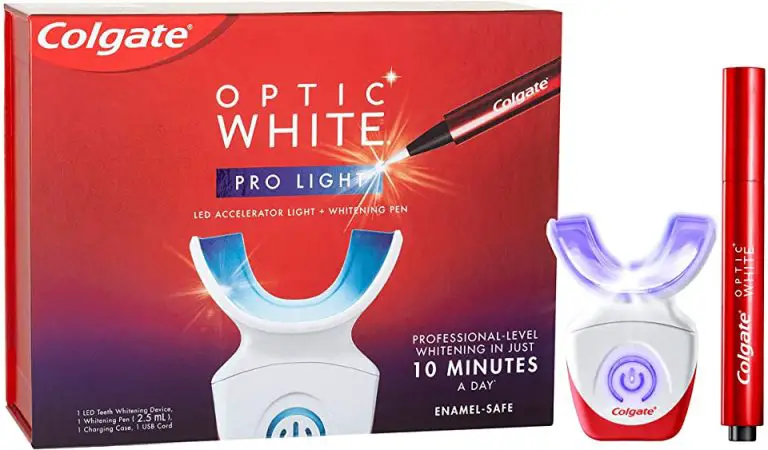Unfortunately, yellowing teeth are part of the aging process and can be sped up by a variety of lifestyle factors, including drinking and/or smoking. Therefore, the teeth whitening business is booming.
There are so many people who are looking for ways to whiten their dull, yellow teeth. In the past, people would go to their dentist’s office for whitening procedures. While this is an effective solution, it’s also a very expensive one.
These days, many celebrities are promoting at-home teeth whitening- which is making the LED whitening kits quite popular. However, some questions arise:
- How does it work?
- Is it safe?
- Is it effective?
Of course, these are just a few of the questions that come up regarding LED teeth whitening that we’ll explore the answers to below.
Hopefully, this will help you decide if LED teeth whitening is a viable option for you.
General Principles of Teeth Whitening
The process of LED teeth whitening works through treating teeth with an agent that may or may not be bleach-based. To speed up the reaction, blue light is shone on the teeth.
In the past, UV was the light source, but some concerns have arisen regarding the risks of UV light. This is because UV light is a source of ionizing radiation that results in the mutation of cells. This is concerning because the oral tissues are sensitive.
Instead, LED light can be used as a safe alternative for whitening teeth. Blue LEDs can be used to speed up the reaction without the risks of UV light.
What is LED Light?
LED, or light-emitting diode, is a device that emits visible light when supplied with an electrical current. This light is typically a single color that falls anywhere from a red to a blue-violet color on the light scale.
These lights are typically intense and usually much brighter than halogen or incandescent lamps. Additionally, they are cooler due to the heat-dissipating designs.
These lights don’t need a lot of power. They are efficient and long-lasting, especially compared to other light sources.
There’s no warm-up time, so when you switch them on, they’re at their highest intensity.
They are not a form of ionizing radiation, so there’s no concern about cell mutation. This means they are a safe alternative to UV light for teeth whitening procedures.
How Does LED Light Whiten Teeth?
LED light alone does not provide whitening properties – but when used alongside a whitening agent, it is a catalyst to speed up the process.
Hydrogen peroxide and carbamide peroxide are often used with LED light.
Is LED Whitening Safe?
LED teeth whitening is a much safer alternative to the older, UV light sources.
However, though the light is safe, this process typically involves putting some form of bleach into your mouth.
Therefore, you must be cautious and follow the instructions that come with your kit.
This process typically involves applying the bleaching agent to your teeth directly or into a tray that fits like a sports mouthguard.
Some trays are one-size-fits-all and others can be custom-fit to your mouth. If the kit contains a tray, the LED light will snap to the tray.
Advantages and Disadvantages of LED Teeth Whitening
Just like anything else in life, there are some advantages and some disadvantages that come with LED teeth whitening. We will explore those below.
Advantages of LED Teeth Whitening
Some of the advantages of LED teeth whitening are outlined below.
Affordable
Most of the at-home LED teeth whitening kits are priced at less than $100, which means it’s more affordable than going to your dentist for an in-office teeth whitening procedure.
While it may not be as long-lasting, an at-home kit is still quite effective.
Convenient
There are lots of options on the market when it comes to at-home LED teeth whitening kits, which means that you don’t have to wait for an appointment time to open up at your dentist.
You can simply purchase a kit and take care of whitening your teeth in your own home.
Effective
When used correctly, these at-home LED teeth whitening kits can be quite effective. They are really easy to use and include detailed instructions for you to follow.
You’ll typically see results quickly and they should last a while.
No UV Radiation
As mentioned, there are some concerns with using UV light in the whitening process.
On the other hand, blue LED light is a much safer alternative. The blue LED light does not have an effect on your tissue at the cellular level and doesn’t cause cell mutations.
Disadvantages of LED Teeth Whitening
Though there are several advantages of LED teeth whitening, there are also a few disadvantages. We will outline those below.
Nothing is Permanent
Because yellowing of teeth is a fact of aging, there’s no method that will be permanent. The rate of yellowing varies from one person to the next and may be sped up by certain lifestyle factors.
Your teeth will continue to yellow due to the natural thinning of the enamel and pigmentation of internal dentin.
This process can take weeks, months, or even years.
Results Based on the Severity of Yellowing
Your results will be determined by the severity of the yellowing of your teeth. If they are very yellow, you may need more treatments.
On the other hand, you don’t want to over-treat your teeth. Be sure to objectively consider the color of your teeth and develop realistic expectations about the color you want to achieve.
Can be Overdone
The instructions that come with your teeth whitening kit will tell you how long and/or how often the process should be done. This is because if it’s left on too long or repeated too soon, damage can be caused to the tooth enamel, which results in sensitivity and other issues.
Pay close attention to the instructions to avoid damaging your teeth.
Not Suitable for Everyone
Keep in mind that not everyone can whiten their teeth.
For example, you should never use whiteners on your child’s teeth. If you’re concerned about the color of their teeth, you should consult a dentist.
Additionally, if you have dentures or restorative dentistry, teeth whitening will be ineffective.
Conclusion
Yellowing teeth are part of getting older. However, there are some options for whitening your teeth.
LED teeth whitening is one of them.
In the past, UV light was used, but due to safety concerns, LED light is used now.
As you can see, it’s affordable, convenient, and effective. However, there are some disadvantages as well.
Hopefully, this will help you determine if this is a viable option to whiten your teeth.

